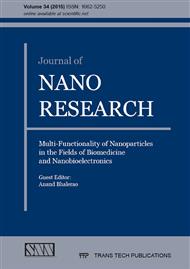[1]
Byron F. Brehm Stecher and Eric A. Johnson, Single cell-microbiology: Technology and Application, Microbiology and Molecular Biology, Reviews, (2004), P. 538–559.
DOI: 10.1128/mmbr.68.3.538-559.2004
Google Scholar
[2]
B. Eisenstein, Iin Principles and Practice of Infectious Disease, eds. Mandell, G. L., Danglers, R. G. & Bennet, J. E. (Churchill Livingstone, New York), Vol. 2, (1989) p.1658–1673.
Google Scholar
[3]
J. F. Jones and et al., Oriented Adhesion of Escherichia coli to Polystyrene Particles, Applied and Environmental Microbiology, (2003) P. 6515–6519.
DOI: 10.1128/aem.69.11.6515-6519.2003
Google Scholar
[4]
H. Bremer and P. P. Dennis, Modulation of chemical composition and other parameters of the cell by growth rate, (1996) p.1553–1569.
Google Scholar
[5]
J. C. Diaz-Ricci, B. Hitzmann, U. Rinas and J. E. Bailey, Comparative studies of glucose catabolism by Escherichia coli grown in a complex medium under aerobic and anaerobic conditions, Biotechnology Prog. , 6: (1990) 326–332.
DOI: 10.1021/bp00005a003
Google Scholar
[6]
R. Reichelt, Atomic Force (AFM) and High-Resolution Scanning Electron Microscopy (HRSEM): A complementary powerful couple, Acta Microscopica Vol 16 No1-2, (Supp. 2) (2007).
Google Scholar
[7]
L. Augusto-Pinto and et al., Review Escherichia coli as a model system to study DNA repair genes of eukaryotic organism.
Google Scholar
[8]
M.Q. Li, Scanning probe microscopy (STM and AFM) and applications in biology, Appl. Phys. A68, 255–258 (1999).
Google Scholar
[9]
X. Jiang, J. Morgan, M. P. Doyle (2002) Appl Environ Microbiol 68: 2605, Klaust D. Jandt, Atomic Force Microscopy for biomaterials surfaces and interfaces, Surface Science 490 (2009) 303-332.
DOI: 10.1016/s0039-6028(01)01296-1
Google Scholar
[10]
M. A. Advincula, D. Petersen, F. Rahemtulla et al (2007) Surface analysis and biocorrosion properties of nanostructured surface sol-gel coatings on Ti6Al4v titanium alloy implants. J Biomed Mater Res B Appl Biomater 80: 107–120.
DOI: 10.1002/jbm.b.30575
Google Scholar
[11]
R. Bos, H. C. van der Mei, H. J. Busscher (1999) Physico-chemistry of initial microbial adhesive interactions: its mechanisms and methods for study. FEMS Microbiol Rev 23: 179–230.
DOI: 10.1016/s0168-6445(99)00004-2
Google Scholar
[12]
D. Que´re´, A. Lafuma, J. Bico (2003) Slippy and sticky microtextured solids. Nanotechnology 14: 1109–1112.
DOI: 10.1088/0957-4484/14/10/307
Google Scholar
[13]
F. Riedewald (2006) Bacterial adhesion to surfaces: the influence of surface roughness. PDA J Pharma Sci. Technol. 60: 164–171.
Google Scholar
[14]
G. M. Bruinsma, M. Rustema-Abbing, H. C. van der Mei et al (2001) Effects of cell surface damage on surface properties and adhesion of Pseudomonas aeruginosa. J Microbiol Methods 45: 95–101.
DOI: 10.1016/s0167-7012(01)00238-x
Google Scholar
[15]
H. Dong, T. C. Onstotta, Kob C-HA et al (2002) Theoretical prediction of collision efficiency between adhesion-deficient bacteria and sediment grain surface. Colloids Surfaces B: Biointerfaces 24: 229.
DOI: 10.1016/s0927-7765(01)00243-0
Google Scholar
[16]
A. Mandlik, A. Swierczynski, A. Das et al (2008) Pili in grampositive bacteria: assembly, involvement in colonization and biofilm development. Trends Microbiol 16: 33–40.
DOI: 10.1016/j.tim.2007.10.010
Google Scholar
[17]
K. Shellenberger, B. E. Logan (2002) Effect of molecular scale roughness of glass beads on colloidal and bacterial deposition. Environ Sci Technol 36: 184–189.
DOI: 10.1021/es015515k
Google Scholar
[18]
G. Binnig, C. F. Quate, C. Gerber, Atomic force microscope, Phys. Rev. Lett., 1986, 56: 930―936.
DOI: 10.1103/physrevlett.56.930
Google Scholar
[19]
T. Tanaka, N. Nakamura and T. Matsunaga, Atomic force microscope imaging of Escherichia coli cell using anti-E-coli antibody-conjugated probe (in aqueous) solutions, Electrochimica Acta 44 (1999) 827-3832.
DOI: 10.1016/s0013-4686(99)00089-4
Google Scholar
[20]
H. J. Butt, , E. K. Wolff, S. A. C. Gould et al., Imaging cells with atomic force microscope, J. Struct. Biol., 1990, 105: 54―61.
Google Scholar
[21]
N. A. Amro, L. P. Kotra, K. Wadu-Mesthrige et al., High-resolution atomic force microscopy studies of the Escherichia coli outer membrane: Structural basis for permeability, Langmuir, 2000, 16: 2789―2796.
DOI: 10.1021/la991013x
Google Scholar


